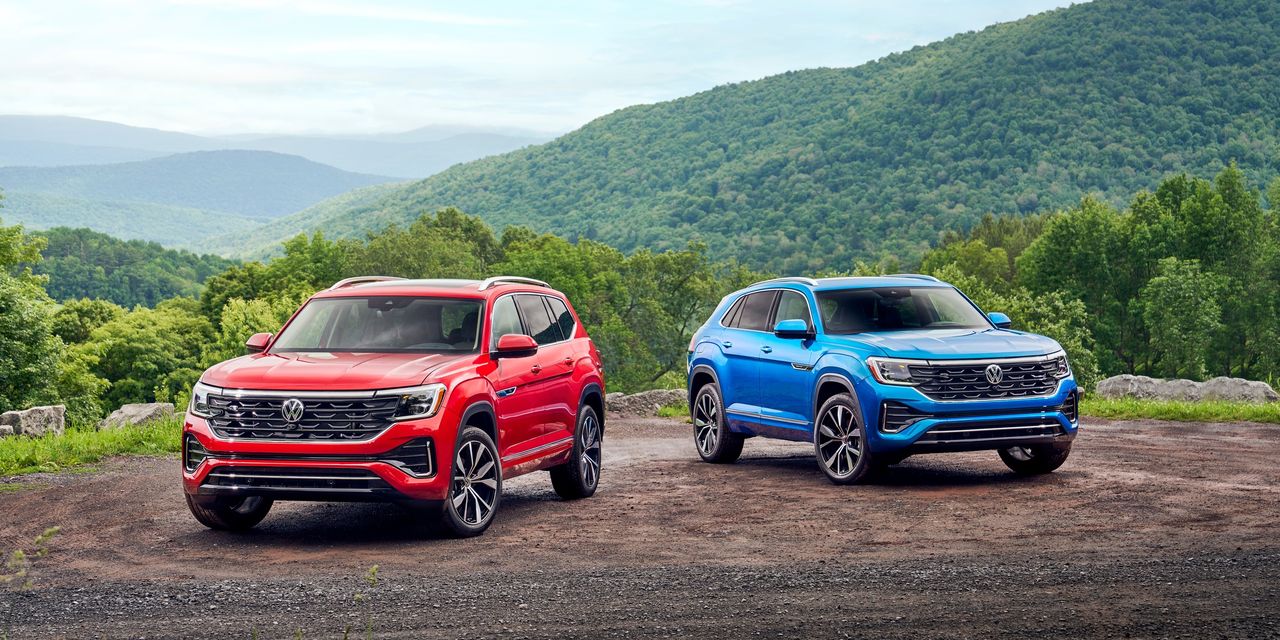Volkswagen is preparing an assault on the American SUV market, with Atlas driving the plans.
“The Atlas is the car we built for the U.S.,” says Andrew Savaas, chief sales and marketing officer for VW North America. “The Atlas nameplate, including the Atlas Cross Sport, is our biggest seller here and our most profitable vehicle.”
The midsized crossover Atlas offers three rows and the Cross Sport version two. The twins were launched, primarily for the U.S. and China (where it’s called the Teramont), in 2017. Domestic production, then and now, is at the company’s Chattanooga, Tenn., plant, which has seen a recent US$1.24 billion investment. For both models, sales in 2022 totaled 82,000, and the company has sold 494,000 since the launch. VW had 6% of the crowded U.S. midsized SUV market share last year.
For 2024, the Atlas and Cross Sport (first introduced in 2020) have been refreshed, and a heavy emphasis has been put on presenting the car as part of the American outdoor lifestyle. That explains why the drive event was held at a rustic camp (with Airstream trailers for guests) in the Catskills. The refreshed Atlas and Cross Sport will be at dealers in the third quarter of this year.
SUVs are critical to VW’s future, and with Chinese sales down, the U.S. market for them is increasingly important. Ten years ago, VW “was a car brand,” Savaas says. For 2013, sedans and hatchbacks (even some station wagons) were 91% of the U.S. product mix. For many buyers then, he says, “The Touareg was too expensive and the Tiguan too small.” In 2022, a whopping 83% of sales were of SUVs.
How important is the new Atlas for VW? In a speech to internal managers last week, the company’s CEO Thomas Schaefer called for belt-tightening, and said that with the heavy costs of developing EVs and increased competition in China forcing discounts, “the roof is on fire” and “all is at stake.” He wants to cut more than US$11 billion in spending over the next three years.
According to Lauren Mulvihill, senior product planner for the Atlas and Cross Sport in the U.S., the 2024 refresh includes a new interior, the switch from two possible engines to just one, and exterior changes including some trendy lighting changes—LEDs front and rear, plus a light bar surrounding the grille, and an illuminated logo. Inside there’s a choice of quilted leather (two-tone in the test car) or cloth, with a 12-inch center display and a smaller 10.25-inch digital instrument panel.
Standard are a height-adjustable passenger seat, heated steering wheel, ventilated front seats, voice control, and new center console storage, plus a suite of safety technology. The rear seats can be heated, but that’s an extra. The big news is the two-liter turbo four-cylinder engine, with 269 horsepower and 273 pound-feet of torque, replacing the choice of a four or the VR6. The new engine allows zero to 60 in 7.6 seconds, up from eight, in front-wheel drive models, and from 8.3 to 7.5 in the all-wheel drives. Torque is up 28% from the VR6.
Fuel economy is so-so. The Atlas SE and Cross Sport provide 22 miles per gallon combined (19 city/26 highway) but the Peak Edition Atlas (which adds 18-inch black wheels with all-terrain tires, body cladding and some black-out trim) drops that to 20 combined (18 city and 24 highway).
The Atlas can tow 5,000 pounds, and the company presented it in the Catskills in conjunction with a vintage-looking Airstream. Mulvihill says the company envisions the typical customer not only camping, but also “kayaking and biking.” Can you hose down the interior? Unfortunately, no.
The Atlas SEL R-Line tested was near peak-Atlas in terms of pricing, US$54,895. And it came with just about everything available, including leather seats and steering wheel, and that heated second row in a 60/40 split configuration.
The Atlas Cross Sport SEL Premium R-Line model tested was also loaded, but a little cheaper at US$53,190. It had the optional second-row captain’s chairs (US$695), so effectively a four-seater. Both the second and third rows in the Atlas were fairly comfortable, with better-than-expected legroom, and access to the third row isn’t too bad. The three-row Atlas has exceptional cargo space. With just the third row folded it’s 55.5 cubic feet; with the second row also, it’s 96.8. Even with all the seats in place, there’s 20.6 cubic feet behind the third row.
The Atlas and Cross Sport look pretty similar, but the latter is five inches shorter, and that means less carrying capacity: 40.3 cubic feet behind the second row, and 77.8 with everything down.
Driving the Atlas/Cross Sport on the twisty Catskills roads was a perfectly pleasant experience, though hardly a white-knuckle thrill ride. It’s a family hauler, not a sports car, but it doesn’t wallow too much on corners. The visibility is excellent, and the cabin quiet. The quality of the materials is high and the fit is good, with plenty of pockets and storage bins. Acceleration is adequate, with no noticeable turbo lag. The brakes were reassuring. There are shift paddles, but few owners will use them. Once again, it’s not a sports car.
Most of the controls are on the center screen, which can be annoying. Navigating the infotainment is not very intuitive. Using the navigation took some acclimatization. But these quibbles probably won’t short-circuit too many sales. The Atlas (probably the better bet over the Cross Sport) starts at US$37,725, which makes it competitive as a three-row SUV. An entry-level Cross Sport is US$36,715.
Read the full article here


